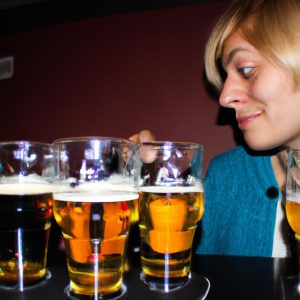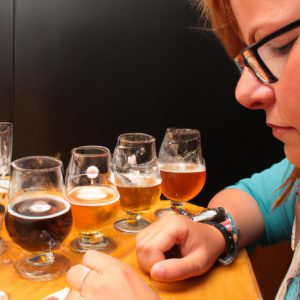Sipping Techniques: A Guide to Beer Tasting in Reviews

Beer tasting is an art form that requires both knowledge and skill to fully appreciate the nuances of different brews. In order to truly savor a beer, one must employ various sipping techniques to engage all the senses. This article aims to provide a comprehensive guide on beer tasting in reviews, offering insights into the proper methods for evaluating flavors, aromas, appearances, and mouthfeel.
Imagine yourself sitting at a cozy pub, surrounded by friends, when you are presented with a pint of amber ale. As you lift the glass to your lips, do you simply take a big gulp or do you pause for a moment to analyze its characteristics? The latter approach is what separates mere consumption from true appreciation. By utilizing specific sipping techniques, such as taking small sips and allowing the beer to coat the palate evenly, one can unlock hidden complexities within each sip. These techniques not only enhance the individual’s experience but also contribute valuable information for those seeking reliable beer reviews and recommendations.
The importance of understanding these techniques cannot be understated in today’s booming craft beer industry. With countless breweries producing an array of styles and flavor profiles, consumers rely heavily on expert opinions to navigate this vast landscape. By mastering the art of beer tasting through proper sipping techniques, consumers can confidently explore new brews and make informed decisions about their beer choices.
One of the first steps in beer tasting is to carefully observe the appearance of the beer. Hold the glass up to a light source and take note of its color, clarity, and head retention. This visual assessment can provide clues about the malt used, brewing techniques employed, and even potential off-flavors or quality issues.
Next, it’s time to engage your sense of smell. Take a moment to inhale deeply and identify the various aromas present in the beer. Is there a strong hoppy aroma? Perhaps hints of roasted malts or fruity esters? By paying attention to these scents, you can begin to anticipate the flavors that will unfold on your palate.
Now comes the most exciting part – taking that first sip. Begin with small sips, allowing the liquid to coat your entire mouth evenly. Pay attention to the initial flavors that hit your taste buds – are they sweet, bitter, or sour? As you continue sipping, notice how these flavors evolve and interact with each other. Is there a balanced harmony or an unexpected contrast?
Additionally, pay attention to the mouthfeel of the beer. Is it light-bodied or full-bodied? Does it have a smooth texture or a more carbonated bite? The mouthfeel contributes significantly to overall enjoyment and can enhance or detract from certain flavor profiles.
Throughout this process, it’s essential to remain objective and avoid personal biases or preconceived notions about specific breweries or styles. Each beer should be evaluated on its own merits rather than comparing it to others.
By mastering these sipping techniques and keeping an open mind, one can truly appreciate all that beer has to offer. Whether you’re a casual drinker looking for new favorites or an aspiring connoisseur seeking deeper knowledge, understanding proper beer tasting methods will elevate your experience and help you navigate the diverse world of craft brews with confidence. Cheers!
Choosing the right glassware for beer tasting
Imagine this scenario: you invite a group of friends over to taste a selection of craft beers. As you eagerly pour each brew, you notice that some glasses showcase the color and aroma beautifully, while others seem lackluster. This experience highlights the importance of selecting the appropriate glassware for beer tasting.
To fully appreciate the nuances of various beer styles, it is crucial to choose glassware that enhances both visual and olfactory aspects. The shape and design of the glass can significantly impact your overall sensory experience. For instance, consider two hypothetical scenarios: in one case, a stout is served in a standard pint glass; in another case, it is poured into a tulip-shaped glass specifically designed for stouts. In the latter scenario, the narrower top allows concentrated aromas to be released slowly as you sip, resulting in an enhanced flavor profile.
When choosing glassware for beer tasting, keep in mind these key factors:
- Shape: Different beer styles have unique characteristics that can be accentuated by specific shapes of glasses. Ales and lagers are best enjoyed from tall pilsner or footed glasses that help maintain carbonation and preserve head retention. Tulip-shaped glasses work well with aromatic beers such as IPAs and Belgian ales.
- Material: Glassware made from clear materials like crystal or thin-walled glass enables better appreciation of color variations and effervescence within the beer.
- Size: Opt for appropriately sized glasses that allow room for swirling without spillage and leave enough space at the top to capture aromas effectively.
- Stemmed vs stemless: Stemmed glasses offer better temperature control since they prevent heat transfer from hands to the beer, whereas stemless options may provide more stability during handling.
Consider this comparison table showcasing different types of glassware commonly used for beer tasting:
| Glass Type | Preferred Beer Styles | Key Features |
|---|---|---|
| Pilsner | Lager, Blonde Ale | Tall and slender |
| Tulip | IPA, Belgian Ale | Bulbous body with flared top |
| Snifter | Stout, Barleywine | Short stem and wide bowl |
| Weizen | Wheat Beer | Curved shape with a wide mouth |
By selecting the appropriate glassware for beer tasting, you can enhance your overall sensory experience. The right choice of glass not only showcases the beer’s appearance but also traps aromas that intensify flavor perception. Understanding the importance of glassware sets the foundation for exploring other crucial aspects such as temperature control in our subsequent section.
Understanding the importance of temperature
Having discussed the importance of choosing the right glassware for beer tasting, we now turn our attention to another crucial aspect – understanding the importance of temperature. To illustrate the significance of temperature in beer tasting, let us consider a hypothetical scenario involving two individuals, John and Sarah.
Paragraph 1: Imagine that John and Sarah are both enthusiastic craft beer enthusiasts attending a local beer festival. They decide to try a particular IPA from one of the renowned breweries at the event. The only difference is that John’s glass is served ice-cold while Sarah’s glass is served at room temperature. As they take their first sips, they notice distinct variations in taste due to the contrasting temperatures. This example demonstrates how temperature can greatly impact the flavor profile and overall enjoyment of a beer.
Paragraph 2: To truly appreciate and evaluate different beers, it is essential to understand how temperature affects them. Here are some key points to consider:
- Cold temperatures tend to dull flavors, making it difficult to discern subtleties in aroma and taste.
- Excessive warmth can intensify certain off-flavors or give an unpleasant boozy character.
- Different styles of beers have varying ideal serving temperatures; for instance, lighter lagers are often enjoyed chilled, while complex stouts may be best savored at slightly warmer temperatures.
- Experimentation with temperature allows you to explore new dimensions within each beer style, revealing hidden nuances that might otherwise go unnoticed.
- Enhance your appreciation for craft beers by discovering diverse flavor profiles through proper temperature control.
- Elevate your sensory experience by exploring different serving temperatures tailored to specific beer styles.
- Mastering optimal serving temperatures will enable you to showcase the brewer’s intended craftsmanship better.
- Understanding this critical factor will empower you as a knowledgeable consumer who can make informed decisions about enjoying various types of beers.
Emotional Table:
| Optimal Serving Temperature | Beer Styles |
|---|---|
| 35-40°F (1.5-4°C) | Pale Lagers |
| 45-50°F (7-10°C) | IPAs |
| 50-55°F (10-13°C) | Brown Ales |
| 55-60°F (13-16°C) | Stouts |
Paragraph 3: By acknowledging the impact of temperature on beer tasting, you can ensure a more enjoyable and authentic experience. Adjusting serving temperatures to suit different styles will unlock a world of flavors that might otherwise remain hidden. In our next section, we delve into another crucial aspect of beer appreciation – the art of pouring beer for optimal aroma and flavor.
Now turning our attention to the art of pouring beer for optimal aroma and flavor, let us explore how this process plays an integral role in enhancing your overall beer-tasting experience.
The art of pouring beer for optimal aroma and flavor
Understanding the importance of temperature is just one aspect of beer tasting that can greatly enhance your experience. Now, let’s delve into another crucial step in savoring a great brew: the art of pouring beer for optimal aroma and flavor.
Imagine you’re at a pub, eagerly waiting to sample a new craft IPA. The bartender places a glass in front of you and skillfully pours the beer with precision. As you observe this process, it becomes clear that how a beer is poured can have a significant impact on its taste and overall enjoyment.
To achieve the perfect pour, consider the following tips:
- Tilted Glass Technique: Begin by tilting your glass at an angle while pouring. This helps control the flow of carbonation and minimizes excessive foam formation.
- Gradual Upright Position: Slowly straighten the glass as you pour to create a gentle cascade effect. Doing so allows any sediment or excess carbon dioxide to escape from the liquid, resulting in cleaner flavors.
- Head Formation: Aim for approximately two fingers’ worth of foam when pouring most beers. However, certain styles may require more or less foam based on their characteristics.
- Clean Edges: Avoid allowing any residue or drips down the side of the glass during pouring. This ensures that each sip remains visually appealing and free from unwanted flavors caused by contaminants.
Now picture yourself having mastered these techniques, ready to indulge in an array of flavorful beers. To further explore different aspects of beer tasting, let us move on to assessing the appearance and color of your beverage.
Assessing the appearance and color of the beer provides valuable insights into its brewing process and potential flavor profile. By simply observing what lies within your glass, you can gain initial clues about what awaits your palate. So next time we’ll focus on unraveling this visual journey before taking that much-awaited first sip!
Assessing the appearance and color of the beer
Transitioning from the previous section on pouring beer, let us now delve into the next important step in beer tasting: assessing its appearance and color. To illustrate this point, imagine you are handed a glass of pale ale with a vibrant golden hue. As you hold it up to the light, you notice that it has a slight haze, indicative of its unfiltered nature. This initial visual inspection already provides valuable information about the beer’s character.
When evaluating the appearance and color of a beer, there are several key factors to consider:
- Clarity: Is the beer clear or hazy? A cloudy appearance can be an indication of unfiltered beers that retain more flavor compounds.
- Color intensity: How dark or light is the beer? The range spans from pale straw-like hues to deep amber shades and even pitch-black for stouts and porters.
- Foam head: Notice the size, thickness, and persistence of the foam on top of your pour. It should ideally form a dense layer that slowly dissipates as you sip.
- Carbonation: Observe the presence and activity of bubbles within your glass. Higher carbonation levels can contribute to a livelier mouthfeel.
- Appreciate the radiant amber glow reminiscent of an autumn sunset
- Marvel at how each bubble dances playfully across the surface like effervescent stars
- Allow yourself to anticipate what flavors might unfold based solely on these visual cues
- Embrace the excitement building inside as you prepare for your first sip
In addition to bullet points, we can also incorporate a table showcasing different colors and their corresponding descriptions:
| Color | Description |
|---|---|
| Pale Straw | Delicate and refreshing |
| Golden | Crisp and inviting |
| Amber | Rich maltiness with caramel undertones |
| Dark Brown/Black | Roasty, chocolatey, and often full-bodied |
As we conclude this section on assessing appearance and color, it is essential to remember that visual cues provide valuable insights into a beer’s characteristics. By taking note of clarity, color intensity, foam head, and carbonation levels, you can begin your journey towards understanding the complexities within each glass. Now let us move on to evaluating the aroma and identifying different scents in our exploration of beer tasting techniques.
Evaluating the aroma and identifying different scents
Building upon the assessment of appearance and color, we now turn our attention to evaluating the aroma and identifying different scents present in a beer. This step is crucial as it provides valuable insights into the complexity and character of the brew.
Evaluating the aroma of a beer allows us to uncover its hidden nuances and discern the various ingredients that contribute to its overall profile. For instance, imagine you are presented with a glass of pale ale. As you bring it closer to your nose, you detect an inviting blend of citrusy hops and subtle floral notes. This initial impression sets the stage for further exploration.
To guide your evaluation process, consider these key steps:
- Take a moment to inhale deeply – this will allow more aromas to reach your olfactory system.
- Note any dominant smells or characteristics that come forth immediately.
- Pay attention to secondary aromas that emerge after some time, as they can reveal additional complexity.
- Use descriptive language when assessing scents, such as fruity, spicy, earthy, or malty.
To illustrate how diverse aromatic profiles can be among beers, let’s explore a selection of popular styles:
| Beer Style | Aroma Description |
|---|---|
| IPA | Intense hoppy scent with citrus undertones |
| Stout | Roasted malt aroma with hints of chocolate |
| Wheat beer | Subtle clove-like spice mixed with banana |
| Belgian Tripel | Fruity esters layered over sweet maltiness |
By familiarizing yourself with common aromas associated with specific beer styles, you’ll become better equipped to identify them during tasting sessions.
Moving forward in our journey towards becoming proficient beer tasters, we will delve into mastering the technique of tasting and assessing beer flavors. Understanding how flavor components interplay is essential for developing a well-rounded palate capable of appreciating all types of beers.
[Transition into subsequent section about “Mastering the technique of tasting and assessing beer flavors”] As we explore the intricacies of taste, it becomes evident that every sip is an opportunity to appreciate the complexity and craftsmanship within a glass of beer.
Mastering the technique of tasting and assessing beer flavors
Transitioning smoothly from the previous section, let us explore the next aspect of beer tasting – mastering the technique of tasting and assessing beer flavors. To illustrate this further, consider a hypothetical scenario where a group of friends gathers for a beer tasting session. Each person is given different beers to taste and evaluate based on their individual preferences.
When it comes to tasting and assessing beer flavors, there are several key techniques that can help enhance your experience:
- Sip with purpose: Take small sips rather than large gulps, allowing the beer to coat your palate fully. This will enable you to pick up subtle nuances in flavor and texture.
- Observe appearance: Before taking a sip, examine the color, clarity, and head formation of the beer. These visual cues can often provide insights into its style and potential flavor profile.
- Assess mouthfeel: Pay attention to how the beer feels in your mouth – is it light or heavy-bodied? Is it smooth or carbonated? This evaluation helps determine aspects such as viscosity and overall texture.
- Identify flavor characteristics: As you take each sip, focus on identifying specific flavors present in the beer. Consider descriptors like malty sweetness, hop bitterness, fruity notes, or hints of spice.
To better understand these concepts visually, refer to the table below which showcases common flavor profiles found in various beer styles:
| Beer Style | Flavor Profile |
|---|---|
| IPA | Citrusy hops with bitter finish |
| Stout | Roasted malt with coffee undertones |
| Wheat Ale | Refreshing with hints of banana |
| Pilsner | Crisp and clean |
By utilizing these techniques and referring to flavor profiles as references during tastings, individuals can effectively communicate their experiences while evaluating different beers objectively.
In summary, mastering the technique of tasting and assessing beer flavors involves mindful sipping combined with observation and analysis. By paying attention to appearance, mouthfeel, and flavor characteristics, individuals can develop a deeper understanding of the complexities within different beer styles. So, grab your favorite brew and embark on a flavorful journey that expands your knowledge and appreciation for the world of beers.



